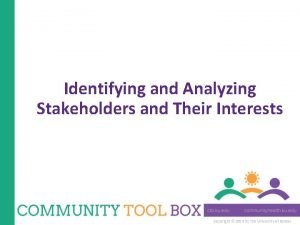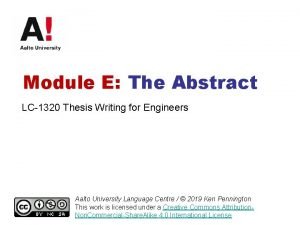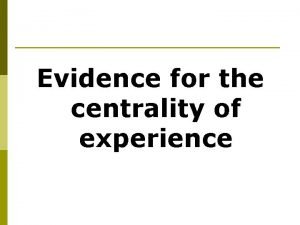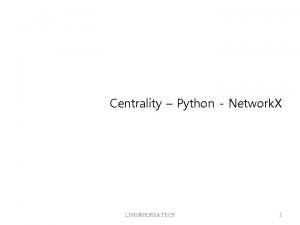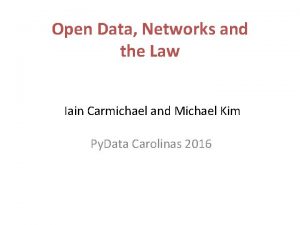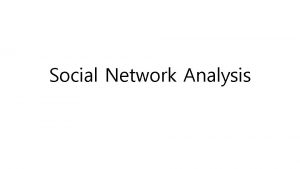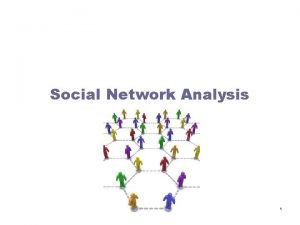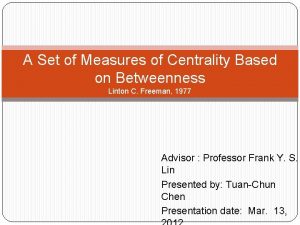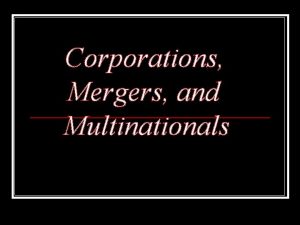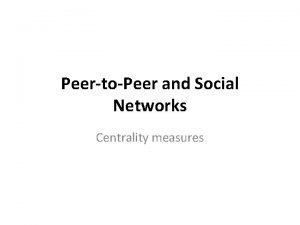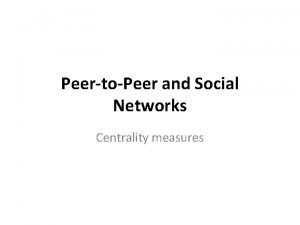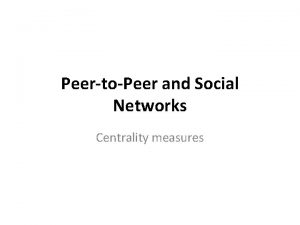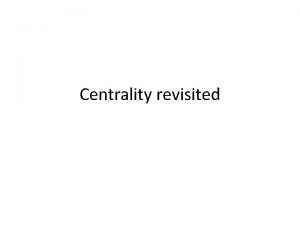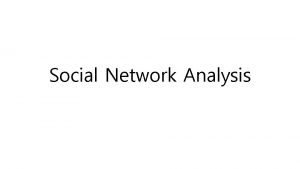Stakeholders Centrality in Modern Corporations and Their Management












- Slides: 12

Stakeholders’ Centrality in Modern Corporations and Their Management Antonio M. Chiesi Department of Social and Political Studies University of Milan Chiesi for Politeia 2008 -05 -22/23

Definitions: a stakeholder is… • any group on which the organization relies in its functioning (Stanford Research Institute 1963) • a party who affects, or can be affected by, the organization’s actions (Freeman 1984). • any actor who has a legitimate interest in the activity of an organization (Clarkson 1999). • Voluntary or involuntary contributors to the activities of an organization, and therefore its potential beneficiaries and/or risk bearers (Post, Preston and Sachs 2002). Chiesi for Politeia 2008 -05 -22/23

Stockholder and Stakeholder approaches Chiesi for Politeia 2008 -05 -22/23

Shifting attention from stockholders to stakeholders interests implies a new definition of corporate strategy • From principal-agent approach, according to which managers are appointed by stockholders in order to maximize their economic return…. • to multi-stakeholder theory, according to which managers, in the name of the firm and for its long term benefit, have to chose a “principal” stakeholder and pursue the balance of interests between a plurality of stakeholders. Chiesi for Politeia 2008 -05 -22/23

Relation between multistakeholder theory and CSR • 1. While in the principal-agent theory, managers have to pursue stockholders’ interests by law, in stakeholder theory their strategies can become indefinite, give them to much power and encourage their selfishness. A danger emerges that in a multistakeholder environment managers turn from agents to brokers. • 2. While stockholders’ interests are (relatively) clear and protected by law, stakeholders’ interests are heterogeneous and not always protected by law, although legitimate. In order to state the strategic orientation of a firm: a) its mission should be declared, b) principles of stakeholder management should be applied, c) some basic values should be adopted (i. e. CSR). • Therefore, while stockholder theory is based on selfish interests recognized and limited by law, stakeholder theory has to be derived from values and goes beyond laws (i. e. CSR). Chiesi for Politeia 2008 -05 -22/23

A map of stakeholders Chiesi for Politeia 2008 -05 -22/23

A more specific inventory of stakeholders Stakeholder Global level National level Local level Stockholders Institutional investors (pension funds, investment funds) small shareholders, Personnel All employees, transnational trade unions International institutions Public administration (UN, EU, ILO, …) Family ownership Domestic employees, Employees living Trade unions at around the plants, local country level unions National government (taxation and norms) Local government (reciprocal influence) The organized community of persons and the environment around the factory Community Humanity at large and future generations (environmental implications) The country (fiscal implications and compliance to law) Customers, consumers Transnational movements (Green Peace, NGOs, . . ) Domestic market, national consumers movements Suppliers International division of labor and subcontracting Domestic suppliers Chiesi for Politeia 2008 -05 -22/23 Local stable suppliers (i. e. industrial districts)

How to manage stakeholder relations (Donaldson & Preston 1995) • Descriptive approach: mapping them and taking into account their positions, • Instrumental approach: using stakeholders’ relations in order to pursue business “as usual”, • Normative approach: identifying values within an axiomatic rationality approach (Weber 1922) and accepting limitations of property rights according to a principle of distributive justice.

Normative stakeholders’ management (modified from Clarkson 1999) • Recognizing them and being informed about their interests (recognition of legitimate conflicts of interests), • Communicating transparently with them (stakeholder dialogue), • Adopting decisions taking into account their positions, • Balancing benefits among different stakeholders (distributive justice), • Cooperating with them in order to minimize negative externalities and encourage the production of public goods: trust, reputation, transparency, accountability (this means that also stakeholders are requested to behave following the same rules of reciprocity)

Theoretical problems in stakeholders’ management • no rules to settle the trade-off between them, • no rules to define a hierarchy of interests among them, • Managers should replace profit maximization function with Pareto efficiency for all stakeholders (which is impossible to compute). • BUT…. . Chiesi for Politeia 2008 -05 -22/23

. . . In practice These three problems are often by-passed in the actual practices adopted in managing every-day relations with stakeholders. Managers try: • to satisfy dynamically all stakeholders, taking into account the relative intensity of their pressures (rather than abstract rules of distributive justice), • to increase their reputation, • to improve the image of an organization, in terms of morality, accountability, sustainability, transparency, fairness. Chiesi for Politeia 2008 -05 -22/23

What is actually done in stakeholders’ management: • Stakeholders have to gain recognition, • and to engage in negotiations in order to get a larger share of resources coming from the organization (value added, transfers, benefits). • Managers are encouraged to give priority to long rather than short term interests, • and are drawn to take care of social and environmental consequences of the organization. • All parties are drawn to conceive the organization as a collective good, • are encouraged to comply with practices of accountability, transparency, reliability, fairness in order to gain reciprocal reputation, • know that unfair practices and moral hazard can destroy the intangible asset everyone can enjoy: social capital (Coleman 1990, Lin 2001). Chiesi for Politeia 2008 -05 -22/23
 Stakeholders and their interests
Stakeholders and their interests Page rank centrality
Page rank centrality Example of abstract in research
Example of abstract in research Centrality of experience
Centrality of experience Katz centrality networkx
Katz centrality networkx Degree centrality python
Degree centrality python Gross national product definition ap human geography
Gross national product definition ap human geography Upper 6 access cavity
Upper 6 access cavity Closeness centrality
Closeness centrality Degree centrality python
Degree centrality python Normalized degree centrality example
Normalized degree centrality example A set of measures of centrality based on betweenness
A set of measures of centrality based on betweenness Corporations mergers and multinationals
Corporations mergers and multinationals
